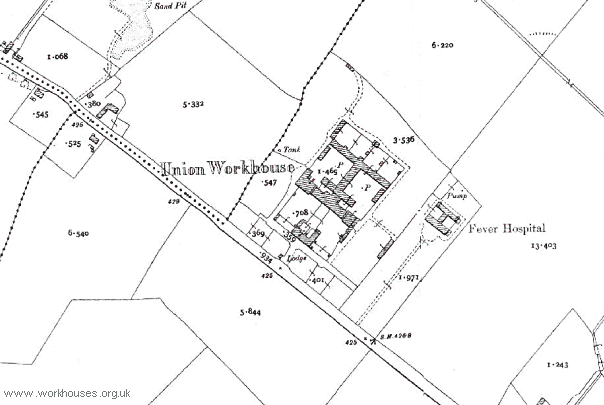Baltinglass, Co. Wicklow
Baltinglass Poor Law Union was formally declared on the 21st November 1839 and covered an area of 223 square miles. Its operation was overseen by an elected Board of Guardians, 21 in number, representing its 11 electoral divisions as listed below (figures in brackets indicate numbers of Guardians if more than one):
Co. Wicklow:
Baltinglass (2), Kiltegan (2), Rathdangan (2), Stratford (2).
Co. Wicklow and Co. Dublin:
Donard, Donoughmore (2), Dunlavin (2), Hollywood (2).
Co. Kildare and Co. Dublin:
Timolin (2), Graney (2).
Co. Wicklow and Co. Carlow:
Rathvilly (2).
The Board also included 7 ex-officio Guardians, making a total of 28. The Guardians met each week on Saturday.
The population falling within the Union at the 1831 census had been 39,646 with divisions ranging in size from Donard (population 1,779) to Rathvilly (5,386) and Baltinglass itself (4,776).
The new Baltinglass Union workhouse was erected in 1840-1 on a 7.5-acre site a mile to the south-east of Baltinglass. Designed by the Poor Law Commissioners' architect George Wilkinson, the building was based on one of his standard plans to accommodate 500 inmates. Its construction cost £5,750 plus £1,050 for fittings etc. The workhouse was declared fit for the reception of paupers on 1st September 1841, and received its first admissions on 28th October. The site location and layout are shown on the OS map from the early 1900s.

Baltinglass workhouse site, 1908.
The main buildings followed Wilkinson's standard layout. An entrance and administrative block faced the road at the south-west of the site. Behind, the main accommodation block contained the Master's quarters at the centre, with male and female wings to each side. At the rear, utility rooms such as bakehouse and washhouse were connected through to the infirmary via a central spine containing the chapel and dining-hall.
On about fifteen occasions during 1843, up to 11 police were were employed in enforcing the collection of rates at places within the union. Military personnel were not used for this purpose, as happened in some other unions.
During the famine in the mid-1840s, accommodation was provided for an additional 40 inmates. A building was hired as a fever hospital for 36 patients.
In May 1920, the workhouse was taken over for military use. In February 1923, it was burnt down by Republican forces.
The site is now occupied by a District Hospital. The former workhouse buildings have been demolished.
Records
Note: many repositories impose a closure period of up to 100 years for records identifying individuals. Before travelling a long distance, always check that the records you want to consult will be available.
- Wicklow Family History Centre, County Council Buildings, Station Road, Wicklow Town, Co. Wicklow.
Bibliography
Links
- None.
Unless otherwise indicated, this page () is copyright Peter Higginbotham. Contents may not be reproduced without permission.


